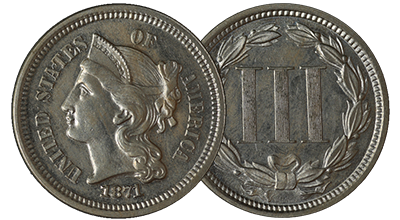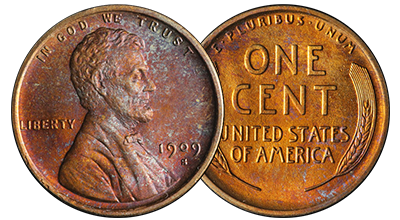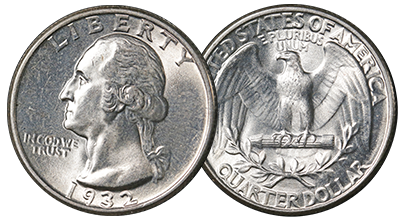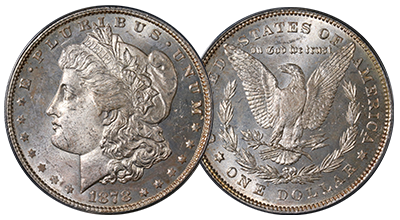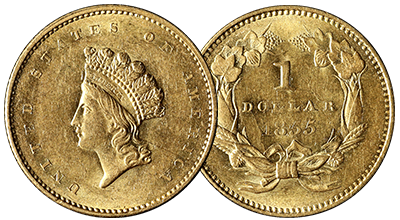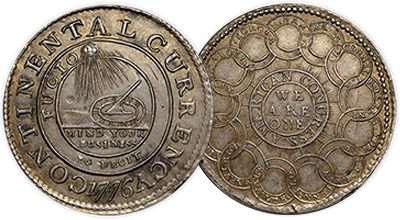Rare Coins For Sale: Classic Collectible Coins
Rare coins are collectible coins that hold value due to their limited mintage, historical significance, unique errors, or high demand among collectors. These coins often appreciate in value over time, making them a popular choice for both numismatists and collectors. Examples include rare Lincoln Pennies, the pre 1933 gold coins, silver dollars and other U.S. Mint issues. Factors such as rarity, condition, mint mark, and precious metal content influence a coin’s worth. If you’re looking to build a collection, rare coins offer historical intrigue and potential growth.
Classic rare coins category offers a selection of rare collectible coins from the Rare Coins to the Pre-1933 Gold. Whether you're a seasoned collector or a numismatist, this section provides a diverse range of coins. Each coin, be it a Barber Half Dollar or a Roosevelt Dime, tells a unique story of its era, making it a valuable addition to any collection. With detailed listings, high-resolution images, and competitive prices, Bullion Shark ensures that every coin enthusiast finds a piece that resonates with their passion and interest.
What Are Classic Rare Coins?
Classic rare coins are U.S. coins that have gained value over time due to their historical significance, limited production, and rarity. These coins, often from earlier periods such as the 19th and early 20th centuries, are considered essential pieces in a collector's portfolio. Examples include the 1909 VDB Lincoln Cent, Morgan Silver Dollars, and Franklin Half Dollars. These coins are celebrated for their craftsmanship and their role in the historical narrative, making them sought-after items among numismatists.
Starting Collecting Rare Coins
For those new to collecting, consider starting with more accessible coins like the Wheat Pennies, 1921 Morgan Silver Dollar or Jefferson Nickels. These coins offer historical significance at a lower cost, making them ideal for building a foundational collection.
Classic Rare Coins for Sale
Our meticulously curated selection includes coins from the earliest days of American coinage to the intricate designs of pre-1933 gold, our collection is a treasure trove for collectors and historians alike.
Classic Rare Coins: History and Value
Rare coins are highly prized by collectors for their historical significance and scarcity. Limited availability, historical context, and the stories they tell. These coins provide a connection to different eras, making them valuable additions to any collection. Rare coins from a wide range of periods, from ancient civilizations to modern-day rarities.
The Value of U.S. Silver Coins
U.S. silver coins, such as the Morgan and Peace Dollars, are particularly appealing due to their precious metal content and numismatic rarity. Their designs reflect the nation’s evolving history, and their scarcity adds to their value potential.
Half Cents to Dollars
Our category spans a wide range of denominations and series, each with its own story and allure:
- Half Cents: The foundation of U.S. coinage, offering insight into the early monetary system.
- Three Cent Nickel: A fascinating piece of history, bridging the gap between copper and silver coinage.
- Cents: From the large cents of the 18th and 19th centuries to the iconic Lincoln Cents, this series captures the evolution of American identity.
- Large Cents, Flying Eagle Cents, Indian Head Penny, and Lincoln Cents each represent significant periods in U.S. history, reflecting changes in design and minting technology.
- Two Cent Piece: A testament to the innovation during a time of change, embodying the motto "In God We Trust".
- Nickels: Trace the journey from the Shield Nickels to the Jefferson Nickels, showcasing America's industrial and artistic progression.
- Liberty Head Nickels (V Nickel), Buffalo Nickels, and Jefferson Nickels each mark distinct eras of American coinage.
- Dimes: A denomination that has witnessed the nation's growth, from the Draped Bust Dimes to the modern Roosevelt Dimes.
- Half Dimes, Seated Liberty Dimes, Barber Dimes, and Mercury Dimes highlight the artistic and historical significance of the dime series.
Rare Quarters to Pre-1933 Gold
- Rare Quarters: From the Draped Bust Quarters to the Washington Quarters, this series encapsulates the essence of American heritage and craftsmanship.
- Seated Liberty Quarters, Barber Quarters, and Standing Liberty Quarters offer collectors a chance to own a piece of numismatic artistry.
- Half Dollars: A denomination rich in history and variety, from the Flowing Hair Half Dollars to the Kennedy Half Dollars.
- Seated Liberty Half Dollars, Barber Half Dollars, and Walking Liberty Half Dollars are jewels in the crown of American coinage.
- Dollars: The epitome of American coin collecting, featuring Morgan Silver Dollars, Peace Dollars, and the historic Eisenhower Dollar.
- Trade Dollars and Seated Liberty Dollars reflect America's expanding trade and economic stature.
The Golden Age: Pre-1933 Gold
- Pre-1933 Gold: A category that shines with the luster of $1 Gold Coins, $5 Gold Coins, and the majestic $20 Gold Coins.
- Territorial Gold and California Fractional Gold pieces offer a glimpse into the Gold Rush era, embodying the adventurous spirit of America.
Colonials, Patterns, and Classic Commemoratives
- Colonials and Patterns provide a unique perspective on the experimental and transitional phases of U.S. coinage.
- Classic Commemorative Coins celebrate significant events and figures in American history, each coin a narrative of achievement and pride.
Classic Rare Coins Value
The world of classic rare coins is filled with remarkable pieces that not only tell the story of their era but also command extraordinary values due to their rarity, historical significance, and condition. Here's a list of some of the most expensive classic rare coins, along with their estimated value ranges and mintages. It's important to note that the rare coins value can vary significantly based on the coin's condition, provenance, market demand, and sales at auction.
-
1794 Flowing Hair Dollar
- Mintage: Estimated 1,758
- Value Range: $1 million to over $10 million
- Notable for being among the first dollar coins issued by the United States Federal Mint, with the finest known specimen selling for over $10 million, making it one of the most valuable coins in the world.
-
1913 Liberty Head Nickel
- Mintage: 5 (unofficially struck)
- Value Range: $3 million to $5 million
- Known as the "V Nickel," this coin is famous for its rarity and the mystery surrounding its unauthorized production. One of the five known specimens sold for over $3.7 million.
-
1804 Draped Bust Dollar (Class I)
- Mintage: 15 known (struck in 1834 or later for diplomatic gifts)
- Value Range: $2 million to $4 million
- Often called the "King of American Coins," it was minted in the 19th century as a presentation piece. Its rarity and historical intrigue make it highly valuable.
-
1933 Saint-Gaudens Double Eagle
- Mintage: 445,500 (but most were melted down; few survived)
- Value Range: $7 million to over $7.5 million
- This gold coin is famous for its beauty and rarity, with one specimen selling for over $7.5 million at auction due to its unique legal standing and historical significance.
-
1894-S Barber Dime
- Mintage: 24
- Value Range: $1.3 million to $2 million
- One of the most sought-after rarities in American numismatics, this dime is prized for its extremely limited mintage and the stories surrounding its creation.
-
1787 Brasher Doubloon (EB on Breast)
- Mintage: Unknown, extremely rare
- Value Range: $4 million to $7 million
- A pre-Federal gold coin privately minted by Ephraim Brasher, a goldsmith and silversmith. Its rarity and historical significance as an early American gold coin make it extremely valuable.
-
1943 Copper Lincoln Cent
- Mintage: Approximately 40 known (struck in error)
- Value Range: $100,000 to $1 million+
- A wartime anomaly, these pennies were mistakenly struck in copper instead of zinc-coated steel, making them one of the most famous error coins.
-
1870-S Seated Liberty Dollar
- Mintage: 9 (estimated)
- Value Range: $1 million to $2 million
- Extremely rare, with only a handful of specimens known to exist, this coin is highly sought after by collectors of Seated Liberty series and rare U.S. coins in general.
-
1822 Capped Bust Gold Half Eagle
- Mintage: 17,796 (only 3 known to exist)
- Value Range: $3 million to $8 million
- One of the rarest U.S. gold coins, with only three specimens known to survive, making it a pinnacle of coin collecting.
-
1796 Draped Bust Small Eagle Quarter
- Mintage: 6,146
- Value Range: $200,000 to $1.5 million
- Highly prized for being the first quarter dollar coin issued by the United States Mint, with its value varying significantly based on condition.
These coins represent the pinnacle of numismatic collecting, embodying both the rich history of coinage and the allure of rare coin collecting. The values listed are estimates and can vary greatly depending on the auction, the coin's condition, and market demand at the time of sale.
Shop now: mercury dimes , for sale, morgan silver dollars, for sale, silver dollars, for sale, wheat pennies, for sale, buffalo nickels, for sale, peace dollars, for sale, indian head pennies, for sale, franklin half dollars, for sale.
Learn more about: which quarters are worth money, how many nickels in a roll, 1953 wheat penny value, quarters worth money, pennies worth money, 1942 penny value, what are nickels made of, most valuable quarters, 1945 wheat penny value, Morgan silver dollars, silver American eagles, Franklin half dollars, 2024 silver eagle coins, burnished silver eagle coins, franklin half dollar, trime, buffalo nickel.
Classic Rare Coins FAQs
The executive order in 1933 that led to the majority of gold being turned in specifically exempted "rare and unusual" coins. This means that Pre-1933 Gold Coins, especially those of numismatic significance, are not subject to potential gold confiscation laws, making them attractive to certain investors.



